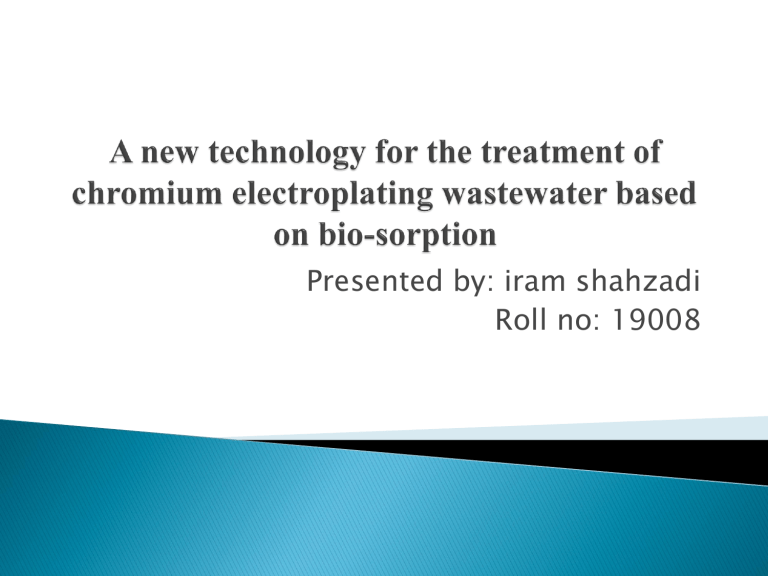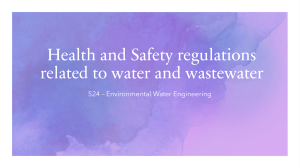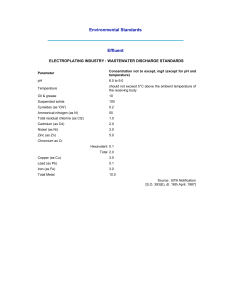
Presented by: iram shahzadi Roll no: 19008 Chrome plating is technique of electroplating a thin layer of chromium on metal object for decorative and protective purposes Wastewaters generated from plating process contain high concentrations of Cr(VI) and low concentrations of soluble forms of various metal salts. Due to its high toxicity Cr(VI) must be removed or reduced to Cr(III) in order to meet the permissible limits to discharge. Traditional plating wastewater treatments include two main steps: Cr(VI) reduction and precipitation of Cr(III) and other metal ions as hydroxides. Electrochemical methods, electro-dissolution of iron and different kind of electrodes (carbon, graphite copper) are used for Cr(VI) reduction. wastewater treatment by ion exchange resins is effective and convenient, they are too expensive to be used by the developing countries. Biosorption is the ability of biological materials to accumulate heavy metals from wastewater through metabolically mediated or physico-chemical pathways of uptake. Biosorption uses biomass raw materials that are either abundant e.g., seaweeds or wastes from other industrial operations e.g., fermentation wastes. Biomass derived from several industrial fermentations may provide an economical source of biosorptive materials. Coffee is the world second most popular beverage after water. The exhausted ground coffee waste, by product of soluble coffee industry used as biosorbent. Exhausted coffee has proved to be an efficient sorbent for the removal of Cr(VI) from both single solutions and binary mixtures with divalent metals the aim was to discover new and low cost sorbents for Cr(VI) removal by sorption. Material Exhausted coffee K2Cr2O7(s) CuCl2·2H2O HCl FeCl3 Al2(SO4)3 53.33 g of with 8 L of samples in a 10 L batch reactor. Sampling was done every 5 min at the beginning of the process. Experiments persisted within the interval of 72– 168 h. Solid particles were separated by filtration and the treated wastewater was stored until it underwent flocculation/precipitation treatment. Alkalization of solution. Addition of 0-4ml of Al2(SO4)3·18H2O and FeCl3 solution. After flocs formation, Solids were separated by filtration. Analytical technique The pH measured by a pH meter Chromium and metals concentration in samples was analysed by flame atomic absorption spectroscopy(FAAS) Hexavalent chromium was analysed by colorimetric 1,5diphenylcarbazide method by using a sequential injection system (SIA). Exhausted coffee is highly efficient to reduce Cr(VI) to trivalent form. Fe(III) present in the effluents partially removed (15–30%). Fe(III) and Fe(II) can be removed by the phenols and tannins of bio sorbents, due to the richness in hydroxyl, carbonyl and amine functional groups of these compounds influence of presence of other metal ions on Cr(VI) sorption efficiency two synthetic solution. S1;- a single Cr(VI) solution and S2 ;a binary mixture of Cr(VI), Cu(II). industrial effluents matrixes affect rate but not the amount of Cr(VI) removed Cr(III) concentration is around 2 folds higher than the one in the synthetic solutions Fe(III) can compete with Cr(III) for sorbent active sites. . correlation between Cr(VI) and Cr(III) concentration in solution and conductivity and pH data. The highest correlation coefficients (R2> 0.99) were found between conductivity and Cr(VI) sorption experimental data conductivity or pH or both parameters can be used to follow bio-sorption evolution and as indicator of end of process. The main advantage of using FeCl3 as flocculating agent is its stability in reaction mixture and good performance for color and turbidity removal. filtration is performed for the removal of sludge and treated water is discharged in to nearby pounds. EC proved to be active reducing agent for the elimination of Cr(VI). The main advantage of Elimination of Cr (VI) by bio-sorption method is cost effective, low electricity consumption and no additional reducing agent . the future technology can readily to be functional for the treatment of chromium contaminated wastewater Bio-sorption is eco-friendly process, suggests the recycling of byproduct instead of discarding by landfill. Nuria Fiol, Jordi Poch, Isabel Villaescusa “A new technology for the treatment of chromium electroplating wastewater based on bio-sorption “doi.org/10.1016/j.jwpe.2016.05.002 2214-7144/© 2016 Elsevier Ltd.




